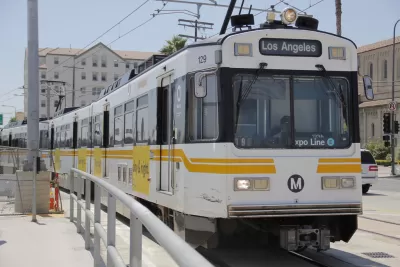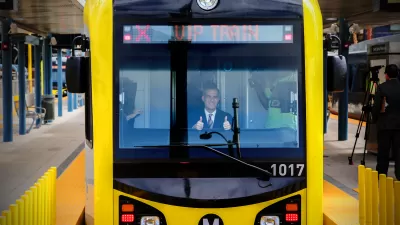The $1.5 billion, 6.6-mile light rail extension from Culver City to Santa Monica is projected to double trips on the line by 2030, giving commuters a viable alternative to driving. Just the same, don't expect the extension to reduce congestion.


Credit: LA Metro Expo Line (note seven new stations: Palms—Santa Monica)
"The light rail extension won’t put a dent in traffic, not in the long run," writes Aarian Marshall for Wired. "But it’s still worth every penny.“
So much for Los Angeles Mayor Eric Garcetti's assurances last February.
The Expo Line connects and crosses through some of our most traffic-ridden corridors,” Garcetti said. “This is a huge step forward in our work to ease congestion.”
Induced demand applies to transit as well as asphalt
Growing the ridership by 35,000 trips to 64,000 in 14 years will be a major feat, but how will the extension impact congestion? Marshall asks transportation expert, Professor Genevieve Giuliano of the University of Southern California (USC) what the effect would be if ten thousand motorists chose to immediately forsake driving and take the Expo Line. Giuliano has been studying the issue.
“Ten thousand vehicles out of literally hundreds of thousands that are moving around—it would be really hard to see,” she says.
In a study published last year, Giuliano and her colleagues used sensor data to take a close look at how the opening of the first phase of the Expo line in 2012 affected congestion in the immediate area. They didn’t see much. “The congestion reduction benefits of [light rail] are likely very limited,” they concluded.
You can thank the rule of induced demand: More space for cars doesn’t mean less traffic, it means more cars. When folks ditch their cars for a smooth and stress-free transit ride, other drivers move to exploit a suddenly less clogged stretch of freeway, either by changing their driving patterns or taking trips they wouldn’t have otherwise. The new Expo Line will move more people more places, sure. But it won’t cure traffic.
Looking at Planetizen posts tagged under the topic, it's easy to see that the concept is generally applied to adding more vehicle capacity, which has the adverse impact of reducing transit ridership, unlike adding transit capacity.
“The best thing you can say is that [the Expo extension] will provide people with an option for traveling in congestion,” says Brian Taylor, director of UCLA’s Institute of Transportation Studies.
Taylor is wary of exorbitant rail projects that are attractive to voters but may "betray 'transit’s critical social service function'": improving the lives of lower income people, particularly when lower-priced, high-frequency bus service may prove more cost effective.
A few streetcar projects that may fall in the category were posted here recently.
A final note on the transit—traffic congestion relationship taught to me by public transit advocate Roy Nakadegawa. While transit may not place much of a dent in traffic congestion, congestion prompts the need to create and improve public transit, as well as adding road capacity. Perhaps the best way to tackle congestion is through economic means.
See more Planetizen coverage of the Expo Line which opened Friday after six years of construction.
Hat tip to Metro Library's L.A. Transportation Headlines
FULL STORY: LA’s New Metro Line Won’t Reduce Traffic—And That’s OK

Planetizen Federal Action Tracker
A weekly monitor of how Trump’s orders and actions are impacting planners and planning in America.

Congressman Proposes Bill to Rename DC Metro “Trump Train”
The Make Autorail Great Again Act would withhold federal funding to the system until the Washington Metropolitan Area Transit Authority (WMATA), rebrands as the Washington Metropolitan Authority for Greater Access (WMAGA).

DARTSpace Platform Streamlines Dallas TOD Application Process
The Dallas transit agency hopes a shorter permitting timeline will boost transit-oriented development around rail stations.

Renters Now Outnumber Homeowners in Over 200 US Suburbs
High housing costs in city centers and the new-found flexibility offered by remote work are pushing more renters to suburban areas.

The Tiny, Adorable $7,000 Car Turning Japan Onto EVs
The single seat Mibot charges from a regular plug as quickly as an iPad, and is about half the price of an average EV.

Supreme Court Ruling in Pipeline Case Guts Federal Environmental Law
The decision limits the scope of a federal law that mandates extensive environmental impact reviews of energy, infrastructure, and transportation projects.
Urban Design for Planners 1: Software Tools
This six-course series explores essential urban design concepts using open source software and equips planners with the tools they need to participate fully in the urban design process.
Planning for Universal Design
Learn the tools for implementing Universal Design in planning regulations.
Municipality of Princeton
Roanoke Valley-Alleghany Regional Commission
City of Mt Shasta
City of Camden Redevelopment Agency
City of Astoria
Transportation Research & Education Center (TREC) at Portland State University
US High Speed Rail Association
City of Camden Redevelopment Agency
Municipality of Princeton (NJ)





























